The 2018 Bodley Head/FT Essay Prize winner: ‘In sickness and in health’
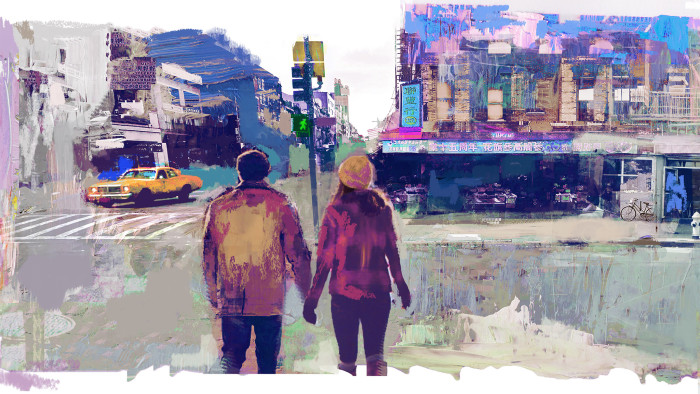
Simply sign up to the Life & Arts myFT Digest -- delivered directly to your inbox.
Why should he record excursions by which nothing could be learned?”
Johnson, Idler 97
As long as we were married we were always running late, but somehow we arrived at the hotel too early to check in. We had an hour to wander the early Sunday streets of lower Manhattan. People were out, as always, but the famous cast-iron façades of Soho were full of dark windows. Luxury stores and the law firms that employed their customers. The few remaining Chinese-owned businesses. National and regional chains in multistorey incarnations on the corners. Almost nowhere to eat.
The hotel was a new building: the first disappointment. It stood at 159 Grand Street, in between Lafayette and Centre, and we never managed to figure out whether we were in Soho or Little Italy or Chinatown. But only new transplants care about those things; old-timers are bored, even offended, by such distinctions. A neighbourhood is a context — people, institutions — and Soho, they tell you, is no more. We were actually too late. The tourists, meanwhile, simply accept what they’re sold. Marketing is the only guide they have. Being young, we imagined ourselves immune to marketing — we would divine our way to the true, secret heart of the city.
Groggy and out of options, we settled for a Starbucks. So much of downtown is nondescript, it’s easy to get lost. It didn’t use to be like this, everyone says, and maybe it wasn’t, but it was by the time we got there, and it’s probably more so now. We slumped into a table by the bathroom. It was New Year’s Day and we had matching low-grade fevers. Our marriage was three days old.
For the amateur historian (that is, a tourist in the past) Manhattan is an inviting subject. Nearly every square foot of the island carries a bushel of documents, most of it online, back to the first Dutch land grants. Before it was our hotel, for example, 159 Grand was a grubby two-story shanty built in the 1860s. There’s a photo of it from 1999, a necrotic frame house on which a yellow awning proclaims many Chinese characters and “Phoenix Poultry Market Inc”. It looks like a stowaway from the punk rock days of the 1970s, or the tenements of a century earlier. The roof is badly bowed and there may not be glass in the second-floor windows. Walls the colour of unbrushed teeth. The buildings on either side — which are still there today — also have signs in Chinese. When we visit in 12 years, they’ll be a French bistro and a wine shop.
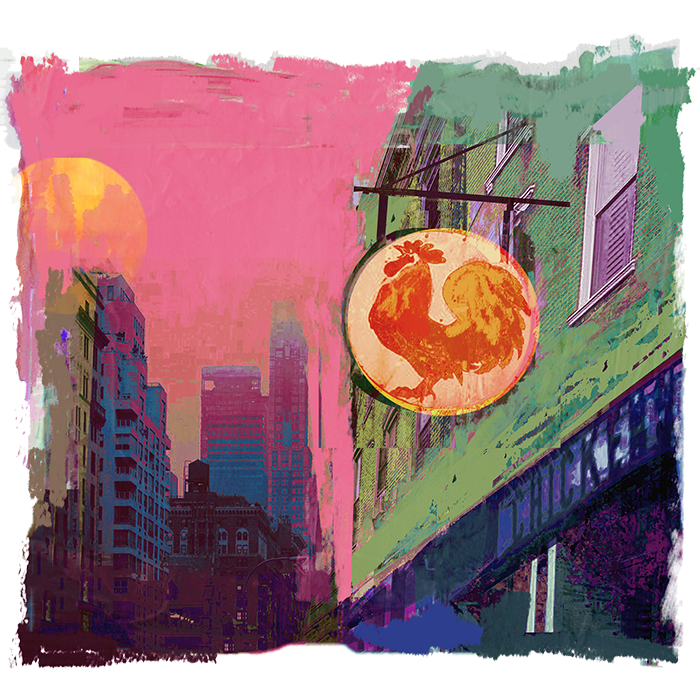
Phoenix Poultry endures in local memory mostly as a smell. It was a working slaughterhouse: you picked out your chicken or duck, and someone dispatched and plucked it for you behind those industrial curtains of half-inch-thick plastic. At the dawn of the 21st century there were still a handful of these places in Manhattan. The only description I’ve found of the inside comes from a defunct vegetarian monthly called Satya. The entry just managed to hold two stacks of cages, eight feet by six, each about five feet tall. About 400 birds were kept in this space, caged too tightly to turn around. Leftovers were tossed in a dumpster around the corner. In the days of trash strikes it must’ve been unbearable to walk past.
By the mid-nineties the neighbourhood had been gentrifying for a decade already. The old police headquarters across Centre Street, where the Bowery drunks used to be hauled in, was turned into luxury condos. It is bracing to picture one of its celebrity tenants — Winona Ryder, say — cracking a window on a hot day to be met with the noise of 400 chickens, the reek of festering gristle. As perfect an image as any for a city busy making itself unrecognisable, again.
We got married in the dead of a Chicago winter, and nearly all our guests were sick. The ceremony crackled with coughs. Somewhere are ill-advised rooftop photos of the wedding party, feigning coatless mirth. In the receiving line, a certain buxom aunt scooped us into a clammy embrace, not letting go before she had gifted us with a sleeper cell of stomach flu. Long preparatory days and anxious nights had left our immune systems with all the defensive might of a used tissue, and while we ate and danced and gladhanded the virus settled in.
On our first wedded night I woke around 2am to find myself alone in bed. We were staying at a friend’s apartment, in a flatiron building in Queens. His bedroom, which he lent to us, was very long and tapered to a point so sharp only one person could stand in it at a time. For five foggy, terrifying seconds I was sure my bride had reneged, fled down the fire escape. I found her in the bathroom on hands and knees, frantically scrubbing in impressive silence. In this way the virus announced itself.
As I took over the cleaning and my wife changed, we diagnosed: the sudden onset, the violence thereof, the timing — precisely six hours after dinner — this was textbook food poisoning. Unfortunate, yes, but it would soon pass. The trip would not be ruined. So I said, several times, as the episode repeated through the night.
No one told me that getting married opens a temporary distance between spouses. However long you’ve known each other, you become, briefly, near-strangers needing reintroduction. Conversation stiffens, you hesitate to touch. The character of the relationship changes in some indistinct way, like an optometrist flipping between two nearly correct lenses. During that time you may make small, unknowing changes, so when you re-emerge into ordinary comfort with each other you are not quite the person your partner married. In our friend’s long pointed bedroom, I was making myself into a relentless optimist. Our honeymoon had a trajectory now, whatever followed had to make up for this. But optimism was new and unnatural to me; the closest I could get was continual reassurance. This would soon pass, I said. The trip would not be ruined.
On New Year’s Day we took the Q train into Manhattan and wandered Soho, waiting to check in. My wife was no better but also no worse, having slept 12 hours. She ventured a bagel. Halfway into it she bolted for the bathroom. It was not food poisoning, nor any kind of shortlived bug, but a raging Siberian winter of a flu. The next day I had it too.
Chickens were butchered at 159 Grand for most of the 20th century. 1908, Barnet Abrahamson; 1921, Max Rothberg; 1939, Charles Falco and sons. Once the stench got into the walls it was probably impossible to do anything else with the place.
In the summer of 1949, when the building was Falco’s Live Chickens and the block was still considered Little Italy, the shop gained some small fame for Georgie, a three-legged rooster. There are no pictures of Georgie’s day, but photos from the mid-eighties show a “Falco’s” shingle hanging out front, though the shop had changed hands again. On the left side of the building is a door to the upper storey — apartments? Who would live above a slaughterhouse? In later photos the door is gone, painted over or boarded up.
In 1979 the Falcos sold to a Chinese property company for $123,000. The building sold again in 1996, in worse shape, for six times that amount. The present hotel’s mortgage, taken out in 2004, is for $5m. Another pocket history of the neighbourhood.
To say it was a New York hotel room is probably sufficient. Ten feet by 14, and most of that was bed. It would have just held all the cages at Phoenix Poultry. Black furniture, white everything else. A place to pass through.
Our room was on the third floor and looked on to a gravel-covered roof. The window had no screen, or else we could remove it, because we climbed out on the neighbouring building to smoke and store our takeout. The view comprised a warren of ductwork, a brick wall, and a small patch of sky. A few windows of the building across Lafayette were visible, in one of which, I swear, sat an Emmy.
The room’s anonymity made our flu-haze worse — deprived of habit, we strained to remember the location of our clothes, the phone charger, the bathroom. We tried making plans for our convalescence, whenever that might be, but it was impossible to talk for long about anything besides whether to eat and what to watch next.
We toured the city through a Law & Order marathon. Here was everything we were missing: Greenwich Village, Central Park, the Upper East Side, Harlem. The detectives visited the bodegas, the brownstones, the churches, and the bars in our stead. They raised their eyebrows at what passed for art in the galleries, they harassed the junkies in the park. Each episode’s end pierced the fog momentarily, reminding us we were in fact in the city we had just been watching, half-asleep in a matchbox room while the time of our lives proceeded without us, just past the window. It was usually then I went for food.
A tourist contracts a place like an illness. Locals have built up or were born with immunity. They don’t look up, they don’t make eye contact, they aren’t impressed. But the uninoculated are bombarded with smells, crowds, architecture, history, and are infected. This is the root of the local’s disdain for the tourist: they are weak, they are sick. They should stay with their own, quarantined in Times Square. They ruin the place for everyone, as a coughing aunt ruins a wedding.
Getting sick, then, gave us some native’s perspective. We had to organise the exotic, disorienting clamour to find practical landmarks: pharmacy, takeout, public toilet. When I left our sickroom for some necessity, I looked like any other New Yorker, head down, shoulders hunched, walking as fast as I could. At times I had such violent chills I wore my wife’s coat under mine.
I tried making the most of my efforts, to sample what offerings of the city I felt we could keep down. Lebanese, for example. Relentless optimism. As soon as I opened the hotel room door, cultural experience in hand, my wife was nauseated by the reek of garlic. I ate in the bathroom, with the fan on, while she turned up Law & Order so I could hear.
We were out of phase: when one felt up to going out, the other felt like dying. We accommodated and compromised, as spouses are supposed to, but the affectionate sacrifices of love became confused with the saccharine deference we all give the ill. Still tourists in our marriage, we had no feeling for the local yet.
At the turn of the century, before any poulterers set up shop, 159 Grand seems to have been a tavern and bordello. In those days the building was owned by the Ball family, who had a carpentry shop there until they moved from a tenement on Prince Street to Connecticut. Such things happened occasionally in the late 19th century. Between the Balls and the Falcos, two families are connected with the building for over a century of its life. A carpenter and a butcher. Imagine a working-class family owning anything on Grand Street today.
The Ball sons closed the shop and leased it out, apparently without too many questions. This backfired somewhat in 1902, when their tenant ran a brothel on the top floor. The exact nature of the operation was the subject of a court case, wherein one of the Balls swore to his ignorance of the matter.
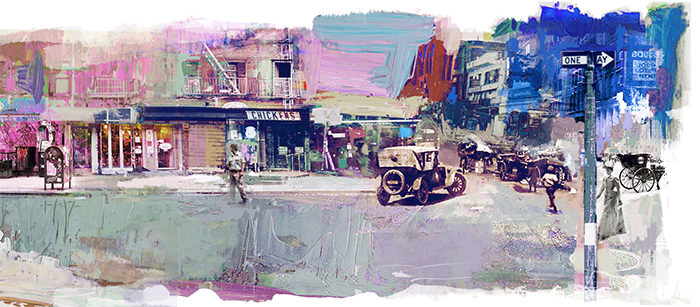
It is worth digressing into the trial transcript for the way it brings the neighbourhood flickering to life. A detective testified to infiltrating the ground-floor saloon at 159 Grand dressed as “a sailor from a cattle steamer.” He enlisted an Italian from the neighbourhood (“they call him Rocko”) because the saloonkeeper spoke no English. A few drinks for himself, a few for the bartender, and then he made it known he was looking for a good time. “We went out in the street to the side of the house, the entrance upstairs” — the same door boarded up in the 1980s — “and went up one flight to a parlour.” What was in the parlour? asked a lawyer. “Women.” How were they dressed? “They had flimsy dresses on.” In 1902 the fee to visit a woman at this establishment was 75 cents. The cops evidently blew their cover — when they came to make arrests the place was deserted.
One floor up and 110 years on from the brothel, we barely knew where we were, or when. Disoriented, we clung to what routines we could make, the predictable comforts of a police procedural. Little arguments helped, they gave us roles to abide in for a few minutes. This became common practice in our marriage. We would exaggerate our beliefs in order to fight about them, though later we had trouble putting them back in proportion.
Our friends in town came to see us, brought food, tried to cheer us up, the atmosphere somewhere between hospital visiting hours and Victorian salon call. We tried to be good hosts — not belabouring our ailments, not asking anyone to watch Law & Order — yet each visit, I thought, smelt faintly but unmistakably of obligation. The tourists were ruining things again.
True, we could have left early. Being miserable in our own home was appealing. But sitting in an airport and then on a plane — unalloyed horror at the best of times — was impossible, and neither of us wanted to be the one to admit the trip was beyond salvaging. Instead we told ourselves each morning, this is a bit better, we can do a little something today, and tomorrow we’ll feel even better.
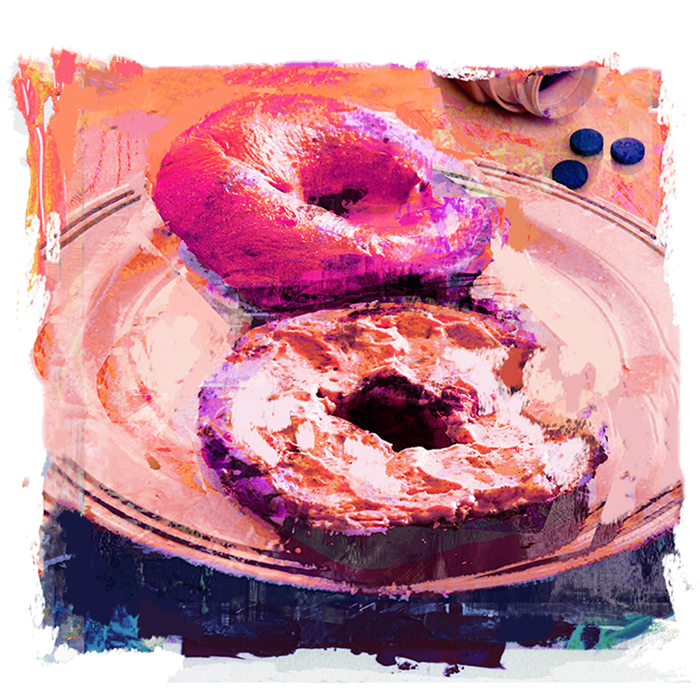
So we made a few excursions. Simple foods first: soup, pierogi, bagels with most of the cream cheese scraped off. We saw a couple of plays: Shakespeare in the Village and a stale musical at one of the depressing multi-stage compounds just off Broadway. We shotgunned Dayquil and made it through a couple of hours at the Met; on its steps I observed a one-legged pigeon. A fellow survivor.
Much went unseen. We walked past, but did not enter, Central Park. We did not see MoMA, the Guggenheim, the Frick, the Cloisters, or the Whitney, nor the Museum of Natural History, the Museum of Sex, or the Irish American Baseball Hall of Fame. We didn’t get to the Museum of Biblical Art, and never would; it closed in 2015. The Museum of Chinese in America was around the corner from the hotel, but we didn’t go. We didn’t see the High Line or go to the Strand. We missed Rockefeller Center, its Christmas tree still lit; we missed uncountable boho night spots. We only saw the Statue of Liberty from the plane home. We managed to go to, if not exactly eat at, a fantastically expensive Korean restaurant down the block from the Empire State Building, where I felt so sick I couldn’t even drink the tea. It had the nicest bathroom I’ve ever thrown up in. We skipped Bach Vespers at Holy Trinity, readings at the 92nd Street Y, the Village Vanguard. We missed Brooklyn altogether. We sent my new in-laws a postcard, an aerial view of Manhattan, Battery Park burning green amidst the steel and glass, the sawtooth piers like industrial fiords: “Wish we were here.”
These limits proved liberating. Where most tourists mournfully accept the impossibility of seeing everything, we rejoiced. Maps and itineraries were thrown out, we could do anything we liked, including nothing. Our misery was a perfect alibi for everything we missed. Thus justified, any fun we did have felt like pure gift, with no opportunity cost. This is perhaps the final reason we stayed — it was the least stressed we’d felt in weeks.
Before the Balls, around the civil war, 159 Grand slips out of focus. There’s a kind of break with the present. There were still farms on Manhattan then. Photography was new and difficult. It’s simple enough to find out who lived and worked there — Isaac Williams, tinsmith; Augusta Piggott, wickmaker — but there are no details, no stories. I know William Buckman lived there when he was drafted into the army in 1863. I know Alice Hepburn stole $30 from the premises in 1852, a pretty good haul back then. But these are only anecdotes, a tourist’s threadbare history — like Soho, they’re nothing without context.
Further back, right after the Revolution, even the maps leave you lost — the whole landscape changes. In 1790 New York City was 33,000 people, some of whom were slaves. George Washington was living in the presidential manor on Cherry Street, rented for $845 a year. Grand was called Anne Street (as in Queen) and only ran from the Bowery to the East River. The hotel site, and much land to the north and west, was the Bayard farm. Two of New York’s mayors were Bayards, in 1685 and 1744 — the family had arrived when it was New Amsterdam. The layout of their fields and paths became the street plan of the neighbourhood.
East of the hotel, where Grand crosses Mott Street, was a knobby hill a hundred feet tall called Bayard’s Mount. A fort was built on it during the Revolution; Nathan Hale was stationed there. Work began on levelling the hill in 1802. South lay the Collect Pond, sometimes called simply “Fresh Water” on the oldest maps. By the 1780s it was undrinkable, ringed with slaughterhouses and tanneries, “a very sink and common sewer”. The city filled it in and built a prison on it.
All this is well-documented, but I can never convince myself it happened. Too much has changed, the continuity is broken. The New Yorks of Phoenix Poultry and Bayard’s Mount and Georgie the three-legged rooster are completely gone; there is some other town where they were. History might as well be a novel, and a frivolous airport novel at that — in all my research, I’ve found nothing of lasting interest about this address. So often it turns out the past has nothing to tell us.
It’s hard enough to accept our own lives happen to us. The divorce became final just short of five years after that trip to Manhattan. My wife could not bear to foreclose the possibility of a better life somewhere else. She owed nothing to the past, she felt — it was a kind of hotel, somewhere to pause before going on. This makes some sense to me now. Rehearsing the memories of our honeymoon, I don’t quite believe I was ever in that dull white room, sick with my bride. It’s an episode of a show I used to watch. Without much conscious effort I have become different, as different as present-day Chinatown is from the days of Phoenix Poultry.
Nothing that happened on our honeymoon made divorce inevitable, but the causes were there, dormant, the same way the Soho grid is there in the plan of Bayard farm. Long before we separated, we knew what it felt like to arrive somewhere and find your expectations thwarted. Afterwards, people asked about my marriage like I’d recovered from an illness. But we don’t recover from the past, as if there were some neutral state we could return to, before it happened. We just become different people. Even if we resist change, try to hoard memories, they leave us. They detach from context and shrivel into anecdotes, then shuffle off even narrative, becoming icons, tableaux vivants.
Today I can stand in the middle of Grand Street and imagine a farm, a pond; I can look up the block and think of a tall hill, try to picture the 18th-century soldiers drilling beside it, but I’ll never see it, any more than old man Bayard could look at present-day Soho and believe it’s his land, or even this earth. To him it would seem like the New Jerusalem. My life is no different. It’s just a story. Once there was a married man, now his ring is in a film canister in my sock drawer. I can’t remember why. Like illness, like travel, history is an exercise in disorientation. It is little wonder if, at the bottom, we doubt we deserve the consequences of our lives. They are like hotel keys we’ve brought home from vacation, that open nothing and lead nowhere, so useless they aren’t even souvenirs.
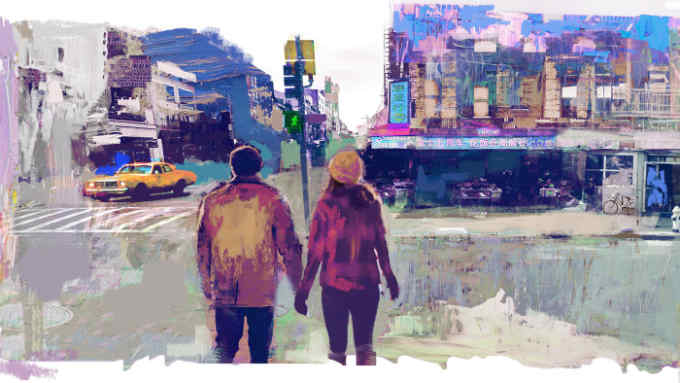
Comments